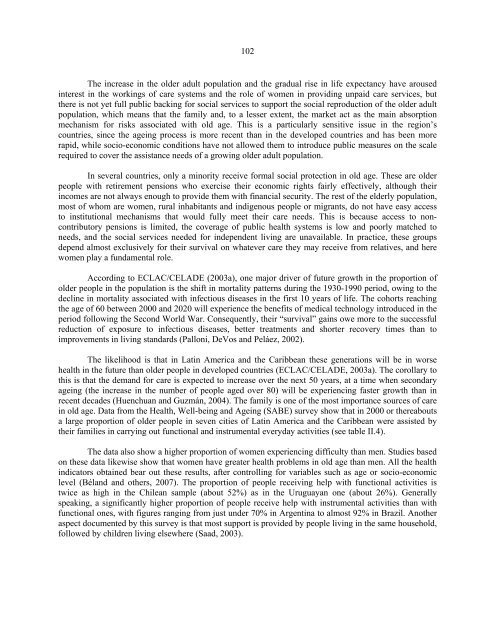Women in Latin America and the Caribbean - Cepal
Women in Latin America and the Caribbean - Cepal
Women in Latin America and the Caribbean - Cepal
You also want an ePaper? Increase the reach of your titles
YUMPU automatically turns print PDFs into web optimized ePapers that Google loves.
102<br />
The <strong>in</strong>crease <strong>in</strong> <strong>the</strong> older adult population <strong>and</strong> <strong>the</strong> gradual rise <strong>in</strong> life expectancy have aroused<br />
<strong>in</strong>terest <strong>in</strong> <strong>the</strong> work<strong>in</strong>gs of care systems <strong>and</strong> <strong>the</strong> role of women <strong>in</strong> provid<strong>in</strong>g unpaid care services, but<br />
<strong>the</strong>re is not yet full public back<strong>in</strong>g for social services to support <strong>the</strong> social reproduction of <strong>the</strong> older adult<br />
population, which means that <strong>the</strong> family <strong>and</strong>, to a lesser extent, <strong>the</strong> market act as <strong>the</strong> ma<strong>in</strong> absorption<br />
mechanism for risks associated with old age. This is a particularly sensitive issue <strong>in</strong> <strong>the</strong> region’s<br />
countries, s<strong>in</strong>ce <strong>the</strong> age<strong>in</strong>g process is more recent than <strong>in</strong> <strong>the</strong> developed countries <strong>and</strong> has been more<br />
rapid, while socio-economic conditions have not allowed <strong>the</strong>m to <strong>in</strong>troduce public measures on <strong>the</strong> scale<br />
required to cover <strong>the</strong> assistance needs of a grow<strong>in</strong>g older adult population.<br />
In several countries, only a m<strong>in</strong>ority receive formal social protection <strong>in</strong> old age. These are older<br />
people with retirement pensions who exercise <strong>the</strong>ir economic rights fairly effectively, although <strong>the</strong>ir<br />
<strong>in</strong>comes are not always enough to provide <strong>the</strong>m with f<strong>in</strong>ancial security. The rest of <strong>the</strong> elderly population,<br />
most of whom are women, rural <strong>in</strong>habitants <strong>and</strong> <strong>in</strong>digenous people or migrants, do not have easy access<br />
to <strong>in</strong>stitutional mechanisms that would fully meet <strong>the</strong>ir care needs. This is because access to noncontributory<br />
pensions is limited, <strong>the</strong> coverage of public health systems is low <strong>and</strong> poorly matched to<br />
needs, <strong>and</strong> <strong>the</strong> social services needed for <strong>in</strong>dependent liv<strong>in</strong>g are unavailable. In practice, <strong>the</strong>se groups<br />
depend almost exclusively for <strong>the</strong>ir survival on whatever care <strong>the</strong>y may receive from relatives, <strong>and</strong> here<br />
women play a fundamental role.<br />
Accord<strong>in</strong>g to ECLAC/CELADE (2003a), one major driver of future growth <strong>in</strong> <strong>the</strong> proportion of<br />
older people <strong>in</strong> <strong>the</strong> population is <strong>the</strong> shift <strong>in</strong> mortality patterns dur<strong>in</strong>g <strong>the</strong> 1930-1990 period, ow<strong>in</strong>g to <strong>the</strong><br />
decl<strong>in</strong>e <strong>in</strong> mortality associated with <strong>in</strong>fectious diseases <strong>in</strong> <strong>the</strong> first 10 years of life. The cohorts reach<strong>in</strong>g<br />
<strong>the</strong> age of 60 between 2000 <strong>and</strong> 2020 will experience <strong>the</strong> benefits of medical technology <strong>in</strong>troduced <strong>in</strong> <strong>the</strong><br />
period follow<strong>in</strong>g <strong>the</strong> Second World War. Consequently, <strong>the</strong>ir “survival” ga<strong>in</strong>s owe more to <strong>the</strong> successful<br />
reduction of exposure to <strong>in</strong>fectious diseases, better treatments <strong>and</strong> shorter recovery times than to<br />
improvements <strong>in</strong> liv<strong>in</strong>g st<strong>and</strong>ards (Palloni, DeVos <strong>and</strong> Peláez, 2002).<br />
The likelihood is that <strong>in</strong> Lat<strong>in</strong> <strong>America</strong> <strong>and</strong> <strong>the</strong> <strong>Caribbean</strong> <strong>the</strong>se generations will be <strong>in</strong> worse<br />
health <strong>in</strong> <strong>the</strong> future than older people <strong>in</strong> developed countries (ECLAC/CELADE, 2003a). The corollary to<br />
this is that <strong>the</strong> dem<strong>and</strong> for care is expected to <strong>in</strong>crease over <strong>the</strong> next 50 years, at a time when secondary<br />
age<strong>in</strong>g (<strong>the</strong> <strong>in</strong>crease <strong>in</strong> <strong>the</strong> number of people aged over 80) will be experienc<strong>in</strong>g faster growth than <strong>in</strong><br />
recent decades (Huenchuan <strong>and</strong> Guzmán, 2004). The family is one of <strong>the</strong> most importance sources of care<br />
<strong>in</strong> old age. Data from <strong>the</strong> Health, Well-be<strong>in</strong>g <strong>and</strong> Age<strong>in</strong>g (SABE) survey show that <strong>in</strong> 2000 or <strong>the</strong>reabouts<br />
a large proportion of older people <strong>in</strong> seven cities of Lat<strong>in</strong> <strong>America</strong> <strong>and</strong> <strong>the</strong> <strong>Caribbean</strong> were assisted by<br />
<strong>the</strong>ir families <strong>in</strong> carry<strong>in</strong>g out functional <strong>and</strong> <strong>in</strong>strumental everyday activities (see table II.4).<br />
The data also show a higher proportion of women experienc<strong>in</strong>g difficulty than men. Studies based<br />
on <strong>the</strong>se data likewise show that women have greater health problems <strong>in</strong> old age than men. All <strong>the</strong> health<br />
<strong>in</strong>dicators obta<strong>in</strong>ed bear out <strong>the</strong>se results, after controll<strong>in</strong>g for variables such as age or socio-economic<br />
level (Bél<strong>and</strong> <strong>and</strong> o<strong>the</strong>rs, 2007). The proportion of people receiv<strong>in</strong>g help with functional activities is<br />
twice as high <strong>in</strong> <strong>the</strong> Chilean sample (about 52%) as <strong>in</strong> <strong>the</strong> Uruguayan one (about 26%). Generally<br />
speak<strong>in</strong>g, a significantly higher proportion of people receive help with <strong>in</strong>strumental activities than with<br />
functional ones, with figures rang<strong>in</strong>g from just under 70% <strong>in</strong> Argent<strong>in</strong>a to almost 92% <strong>in</strong> Brazil. Ano<strong>the</strong>r<br />
aspect documented by this survey is that most support is provided by people liv<strong>in</strong>g <strong>in</strong> <strong>the</strong> same household,<br />
followed by children liv<strong>in</strong>g elsewhere (Saad, 2003).











